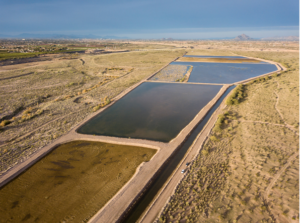Publication
Long-Term Storage Credits: Securing Arizona’s Water Future
By John Habib, John D. Burnside, L. William Staudenmaier, and Fred Breedlove
This article is Part 5 of Snell & Wilmer’s series on Arizona’s water supply and legal framework. So far in this series we have examined the most common and most-used water sources in Arizona’s diverse water portfolio: groundwater, surface water, and Colorado River water. This article describes Arizona’s long-term storage credit (LTSC) system, which provides a mechanism for the storage of water underground for future use. Over nearly two decades, the LTSC system has generated a reliable supply of stored water that may be accessed by municipal water providers, developers, industrial users, and others that either store water directly or purchase credits through an active market. The system also provides a backup supply of water intended to help municipal and tribal users of Colorado River water through times of shortage.
The Impetus
In 1994, Arizona’s legislature—recognizing continually growing water demands, significant groundwater overdraft, and surface water supplies with diminishing reliability—passed the Underground Water Storage, Savings, and Replenishment Act (the Act). The Act stated Arizona’s public policy to encourage use of renewable water supplies, particularly the State’s entitlement to Colorado River water delivered by the Central Arizona Project (CAP), through a flexible and effective program for the underground storage, savings, and replenishment of water. The result of the Act is Arizona’s system of long-term storage credit (LTSC) accrual and use that is vital to maintaining Arizona’s water future.
The Framework
Certain types of renewable water may be used to obtain LTSCs when stored in an Underground Storage Facility (USF) or Groundwater Savings Facility (GSF) if the water “cannot reasonably be used directly.” The Act includes a complex definition of “water that cannot reasonably be used directly”. A.R.S. § 45-801.02(23). While the details of this definition are highly fact-specific, under the right circumstances, both CAP water and effluent will qualify. Effluent is the focus of an upcoming article in this series.

Water storers that do not qualify under the definition of “waters that cannot reasonably be used directly” may still be able to engage in “annual storage and recovery” of water, in which water is stored in a permitted USF or GSF and is recovered by the storing party during the same calendar year. Although this system is not as flexible as LTSCs, it can nevertheless be a viable means for water users to temporarily store water to even out fluctuations in supply and demand over the course of a year and effectively address water treatment issues via aquifer storage and recovery.
The Arizona Department of Water Resources (ADWR) issues three types of permits under the Act: (i) storage facility permits (to operators of USFs and GSFs); (ii) water storage permits (to entities that seek to store water at a USF or GSF); and (iii) recovery well permits, which authorize a water storer or party that acquires LTSCs to withdraw stored water from an aquifer. ADWR maintains separate accounts for every holder of LTSCs to ensure accurate tracking of credits earned, transferred, and recovered.
Storage facility permits authorize a USF or GSF operator to store water either on its own behalf or on behalf of third parties that secure approval from the USF or GSF operator to store water at the facility. The application process for both USFs and GSFs is rigorous and requires satisfaction of both legal and technical aspects to secure a permit.
A USF is a direct recharge facility where water enters the aquifer, either through injection wells or percolation basins (a “constructed” USF) or through a natural stream channel (a “managed” USF). An injection well injects water into an aquifer, while a percolation basin allows water to percolate into the aquifer.
A GSF is a facility that would otherwise withdraw and use groundwater but instead agrees to reduce its groundwater withdrawals on a “gallon for gallon basis” for quantities of renewable water (CAP or effluent) delivered to the GSF “in lieu” of pumping groundwater. GSFs save groundwater by leaving water underground that would have otherwise been pumped and used. One common example of a GSF is an irrigation district that supplies its irrigation customers with CAP water or effluent from a wastewater utility rather than with pumped groundwater. The irrigation district secures the GSF permit and operates the GSF, while the entity providing the “in lieu” water supply (e.g., CAP water or effluent) accrues the resulting LTSCs.
Benefits of the LTSC System
ADWR estimates that enough renewable water has been stored by the LTSC system to supply the City of Phoenix for 30 years. In addition to providing a means to store renewable water supplies underground for future use, the LTSC system also results in significant benefits to Arizona’s groundwater supplies by imposing a “cut to the aquifer.” In general, ADWR credits 95% of stored water to the storer’s long-term storage account. The remaining 5% is deemed a “cut to the aquifer.” This deduction has resulted in substantial aquifer recharge over and above the amounts of water that accrues as LTSCs.
Subject to certain requirements, a holder of LTSCs is entitled to withdraw water from the aquifer in a quality equivalent to the amount that was stored to obtain the LTSCs (less the 5% “cut”). Although LTSC water is withdrawn from the ground, the water retains the legal character of the renewable source that was stored to obtain the credit. Therefore, owners of LTSCs may be able to pump water within Active Management Areas (AMAs) (such as Phoenix and Tucson) even without holding an independent legal right to pump groundwater.
Further, LTSCs do not expire and can be sold at prices set by market transactions. Various entities hold large quantities of LTSCs that may be available for sale, such as Gila River Water Storage (GRWS), which markets LTSCs generated by storage of the Gila River Indian Community’s CAP entitlement. The availability of LTSCs provides developers, commercial and industrial users, and municipalities with flexibility to obtain water to be used (or not used) when and where it is needed. For example, developers may purchase LTSCs to satisfy the Assured Water Supply program’s requirement to demonstrate availability of a 100-year supply of renewable water for a new subdivision.
The largest holder of LTSCs is the Arizona Water Banking Authority, which was established by the Arizona Legislature in 1996 to store excess CAP water as a resource to mitigate the effects of future Colorado River shortages on municipal and industrial users and to provide a source of water to support settlement of Indian water rights. The Arizona Water Banking Authority holds 2,045,155 acre-feet of LTSCs in the Phoenix AMA, 1,491,414 acre-feet in the Pinal AMA, and 849,933 acre-feet in the Tucson AMA.
Cities also hold significant LTSCs. In the Phoenix AMA, Phoenix holds 369,253 acre-feet; Mesa holds 552,469 acre-feet; Scottsdale holds 246,911 acre-feet; Gilbert holds 448,731 acre-feet; and Tempe holds 76,406 acre-feet. In the Tucson AMA, Phoenix holds 196,876 acre-feet and Tucson holds 550,726 acre-feet.
In all, there are 8,103,609 acre-feet of LTSCs stored in the Phoenix AMA. There are 2,397,302 acre-feet stored in the Tucson AMA, and 3,146,204 acre-feet stored in the Pinal AMA. Finally, there are 70,549 acre-feet of LTSCs stored in the Prescott AMA.
Over its nearly 20-year existence, the LTSC system has leveraged Arizona’s entitlement to annual deliveries of Colorado River water into a large and flexible long-term water supply, while increasing the geographic reach of renewable water supplies by utilizing the aquifer to store, convey, and recover renewable water. The system has created an active market for LTSCs, allowing water supplies to be used in a manner consistent with economic incentives. The LTSC system is an example of the advanced, sophisticated management of water resources that is effective throughout much of Arizona and which serves to increase the reliability and resilience of Arizona’s water supply for future economic development.
About Snell & Wilmer
Founded in 1938, Snell & Wilmer is a full-service business law firm with more than 500 attorneys practicing in 17 locations throughout the United States and in Mexico, including Phoenix and Tucson, Arizona; Los Angeles, Orange County, Palo Alto and San Diego, California; Denver, Colorado; Washington, D.C.; Boise, Idaho; Las Vegas and Reno-Tahoe, Nevada; Albuquerque, New Mexico; Portland, Oregon; Dallas, Texas; Salt Lake City, Utah; Seattle, Washington; and Los Cabos, Mexico. The firm represents clients ranging from large, publicly traded corporations to small businesses, individuals and entrepreneurs. For more information, visit swlaw.com.




